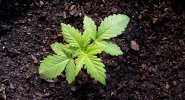Cannabinoids have become a topic of interest in recent years not only among cannabis enthusiasts, but also among scientists, medical and pharmaceutical experts. Their influence on the human body seems to be underestimated, and their health-promoting properties undiscovered. Each year we learn more and more about cannabinoids, and the knowledge we gain is increasingly surprising. Why are the compounds contained in marijuana, including THC, CBD, CBG and THCV, so special?
Always in the group
THC has until recently been identified with the feeling of a specific high, and associated only with psychoactive effects. We now know that THC is also responsible for pain relief and also has a significant effect on other cannabinoids, so they interact more effectively with our bodies and can exhibit health-promoting properties.
This also works the other way around. People who insist on using only marijuana with sky-high levels of THC are wrong, because in order to unleash the full power of THC, other cannabinoids are needed to amplify its effect.
Pharmacists can most often tell us the amount of THC, CBD, CBG, THCV in a given blend or strain of marijuana. By understanding the simple relationship between these four cannabinoids ourselves, we can tune their effects to our unique needs.
THC, CBD, CBG, THCV - how THC (delta9-tetrahydrocannabinol) works
THC is the main psychoactive ingredient in marijuana buds and mimics the effects of anandamide, which is a naturally occurring cannabinoid in the brain.
Brief description of THC:
- THC appears to provide some positive health benefits, especially when combined with other cannabinoids, - THC has the strongest psychoactive effects of all known cannabinoids, - with THC we are able to fall into a state of heightened creativity, curiosity, excitement or amusement, - high levels of THC can cause feelings of anxiety, disorientation, hallucinations or even hallucinations.
THC appears to:
- dull some types of pain - help protect the brain from degeneration over time - acts as a neuroprotective agent, - allow for better rest and relaxation, - contribute to feelings of incredible euphoria - may aid in the treatment of mood disorders, - affect changes in perception and, for example, bend the perceived passage of time.
How do you get high levels of THC in marijuana?
THC levels in buds are mainly determined by strain (genetics). This compound is found primarily in the trichomes on marijuana buds and, in the case of very specific strains, also on the leaves, stems and other parts of the plant. Increasing total resin production in a strain with high THC usually increases total THC levels. The best results are achieved by planning the harvest when the trichomes are milky white or cloudy with just a few amber tips - when these start to appear they show the highest levels of THC
Keep in mind, however, that having a high THC content by itself does not necessarily mean that the cannabis is great and of good quality. It's important to look at the entire experience that comes with smoking such a strain, taking into account the effects of CBD, CBG, and THCV. In fact, many of the negative effects of taking too much THC can often be avoided by offsetting it with just other cannabinoids. These unpleasant symptoms include: - gaps in memory, - disorientation, - anxiety, the onset of anxiety attacks, and panicky fear.
CBD (cannabidiol)
Scientists have known about CBD since the very beginning of marijuana research, but it was not originally thought to have much effect on the body. Modern research has proven how wrong the scientific world was, and as a result, we now know that CBD shapes the individual experience of smoking marijuana, as well as having a significant impact on health.
A brief description of CBD
- CBD is not psychoactive and does not in any way affect the specific feeling of high that accompanies smoking marijuana, - CBD appears to have many positive health properties, the list of which is getting longer every year. Some scientists believe that in the future CBD will be able to replace a large group of chemical drugs, - the presence of CBD may reduce some of the subjective effects of taking THC. Higher concentrations of CBD reduce the psychoactive effects of THC, which could be a great way for some patients to get the medical benefits of THC without having to be high all the time.
CBD appears to:
- reduce pain (of any kind), - prevent anxiety attacks and muscle spasms - help treat inflammation - have a long-term positive effect on mood, - protect the brain from aging (has neuroprotective effects). - promote feelings of calmness and relaxation, - act as an antipsychotic in people suffering from schizophrenia, - offer help to people suffering from multiple sclerosis, fibromyalgia and epilepsy, - have an effect on stopping cancer by inhibiting the growth of cancer cells, - prevent memory damage and confusion associated with THC use.
How do you get high levels of CBD in marijuana?
Like THC, the CBD content in buds depends mainly on the strain (genetics). CBD is often confused with CBN, which can affect harvesting methods. There aren't many options to increase CBD levels, other than choosing the right cannabis strain. CBD often occurs naturally in higher amounts in low-temperature cannabis strains, and often appears in higher levels in autoflowering strains from the wild cannabis genus.
Curiosity
British pharmaceutical company GW Pharmaceuticals has developed Sativex, which contains 50% of both THC and CBD derived directly from marijuana. Sativex appears to be very well tolerated and doesn't have many side effects similar to those you might encounter when taking Marinol - which is a synthetic drug made from 100% THC.
THCV (tetrahydrocannabivarin)
Brief description of THCV:
- is a homologue of THC (meaning it has similar structure and properties, and can be written using the same chemical notation), - has psychoactive effects, but minimally different than those associated with THC, - requires a higher boiling point - as high as 220o,
THCV appears to:
- increase the euphoria induced by THC while shortening the duration of its effects, - reduce appetite - so helps lose weight, but does not work well for treating eating disorders, - regulate blood sugar levels and affect insulin resistance, - reduce the risk of anxiety attacks and panic attacks, - clear the mind, it helps to distinguish between fiction and reality, - help in the treatment of alzheimer's, - have a positive effect on the skeletal system. osteoporosis.
CBG (cannabigerol)
Brief description of CBG:
- according to scientists, may be the stem cell of THC and CBD, so it has some of the characteristics of both compounds, - has no psychoactive effects, - usually makes up less than 1% of the composition of a given marijuana strain.
CBG appears to:
- reduce the sensation of pain, especially neuropathic pain (research suggests it works better than CBD for this purpose), - inhibit GABA reuptake in the brain, which may reduce anxiety and muscle tension, - have antidepressant effects similar to imipramine, - reduce intestinal inflammation, aid in the treatment of Crohn's disease, - improve complexion, moisturize the skin and support the treatment of numerous skin conditions, - reduce intra-ocular pressure, which may be beneficial in the treatment of glaucoma, - exhibit neuroprotective properties, which may show promise in the treatment of neurodegenerative diseases such as Huntington's disease and multiple sclerosis, - have antiseptic properties, - be a potential treatment for a wide range of cancers such as breast, lung, pancreatic, ovarian, kidney, bladder and colorectal.










